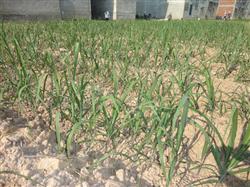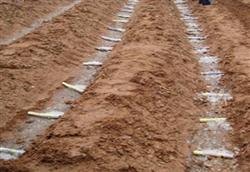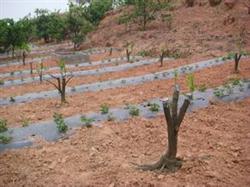Interplanting technique of Spring Peanut and Sugarcane

First, the advantages of interplanting between spring peanut and sugarcane 1. Improve the multiple cropping index. Peanut is a clustered crop with short seedlings and sugarcane is a long-stalked crop with erect and long growing period. it is interplanted by making use of the time difference between the two planting periods and the space of seedling growth, that is, planting peanuts first and then planting sugarcane in the prepared spring sugarcane field, which increases the economic income of peanuts. two。 Easy to operate. Planting sugarcane among peanuts only ploughs a trench between rows of peanuts to plant sugarcane, which is easy to operate and can stagger the busy spring ploughing season. 3. Increase the organic fertilizer of sugarcane. After peanut harvest, burying bean vine, residual bean root and litter into sugarcane head can increase sugarcane organic fertilizer and sugarcane yield. Second, intercropping techniques 1. Fine ground preparation. Peanut needle penetration, pod expansion, root growth, rhizobium breeding and nitrogen fixation activities all need a loose, deep and fertile soil environment. And sugarcane also needs such a soil environment. Therefore, it is necessary to carefully prepare the soil and improve and fertilize the soil in order to obtain high yield. The cultivated land is generally ploughed two ploughs and two harrows with tractors, which is deeply loose and does not disturb the soil layer, with a depth of up to 35 cm. If there is no machine ploughing, cattle ploughing and harrowing can be used to reach the standard of deep, loose, flat and broken soil. two。 Arrangement of planting date. Planting period of spring peanuts: the planting time of spring peanuts in Xuwen County is around "Greater Cold" or in late January, and planting in warm weather (the temperature is above 16 ℃). Peanuts planted during this period can be planted before and after the mild and sunny Ching Ming Festival blossoms to avoid the hot and dry westerly weather in May, which is conducive to peanut needling and pod expansion. Sugarcane planting period: mastering the time of planting sugarcane is the key to achieve double harvest of peanut and sugarcane. According to experience, it is most suitable to plant sugarcane 32-40 days after peanut planting, that is, from late February to early March. If sugarcane is planted too early, sugarcane will compete with peanuts for space, sunshine, soil fertility and fertilizer, affecting peanut photosynthesis and its yield. If the planting of sugarcane is too late, the peanut seedlings grow and cover the sugarcane seedlings, resulting in the lack of sunshine, lack of seedlings and withered seedlings, affecting the yield of sugarcane. 3. Select suitable sugarcane varieties. It is best to choose sugarcane varieties with high yield and narrow leaves, slow growth in early stage, fast growth in late stage and more tillers. 4. Reasonable close planting and adequate basal fertilizer. Peanuts have a small row spacing of 35 cm and a large row spacing of 45 cm, planting 9000 to 9500 holes per mu with 2 seeds per hole, and applying 2500 kg of high-quality soil and miscellaneous fertilizer, 30kg of standard nitrogen fertilizer, 40kg of superphosphate, 10kg of potassium sulfate or 100kg of plant ash per mu. The row spacing of sugarcane is 75100cm, and there are 3000 double-bud seedlings per mu. Sugarcane base fertilizer is mainly organic fertilizer, supplemented by inorganic fertilizer, that is, high quality soil fertilizer 2500 kg, calcium superphosphate 100kg, urea 25kg, compound fertilizer 50kg, carbofuran 3kg, mixed in sugarcane ditch as sugarcane base fertilizer. 5. Strengthen field management. After the harvest of spring peanuts, the sugarcane was re-applied with quick-acting fertilizer for tillering, 25kg urea per mu, ploughing and loosening the soil, weeding, and burying bean vines and residual bean roots and litter into the head of sugarcane. When the soil moisture is insufficient, it is necessary to irrigate to promote the tillering of sugarcane, attack the number of seedlings, and grow early and quickly.
- Prev

How to cultivate water-saving sugarcane in winter and spring
Paddy sugarcane is one of the important types of sugarcane cultivation in Yunnan. Many sugarcane cultivation areas in our province have serious soil erosion, irrigation and water conservancy facilities construction lags behind, coupled with drought in winter and spring and lack of water in paddy fields. Except that some fields can plant sugarcane according to the festival requirements, most of the paddy fields are planted late, from the end of April to the end of April.
- Next

How to prevent and cure the three major diseases of navel orange
The fruit characters of navel orange grafted on adult mandarin trees were normal in the first two years, and then the bad characters of variety degradation appeared year by year: shorter shoots, smaller leaf shape, lighter leaf color and weaker tree potential. Fruit rate decreased, fruit shape became smaller, pericarp dim and dull, flavor became lighter and fruit quality decreased. In production practice.
Related
- Moge, come on! The staff of the peasant association in the producing area of cantaloupe were frightened when the crowd gathered.
- Causes and Solutions of low Fruit setting rate of Apple
- Symptoms and control measures of passion fruit virus disease
- Fruit growing lesson: how do apple orchards keep high yields?
- Can you build orchards in the mountains? What are the pros and cons?
- How to manage the coloring period of Crisson grape?
- This paper introduces the processing technology of two kinds of fig products.
- How much is a month for retired teachers in rural areas by 2020?
- How can strawberry planting increase sugar content? We should pay attention to management in many aspects.
- What are the cultivation techniques on how to improve the yield of golden fruit?

